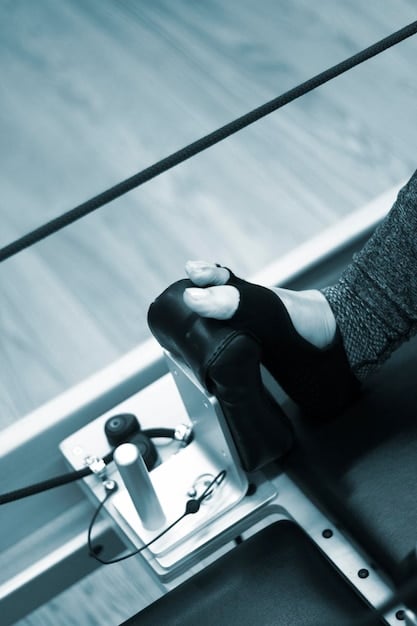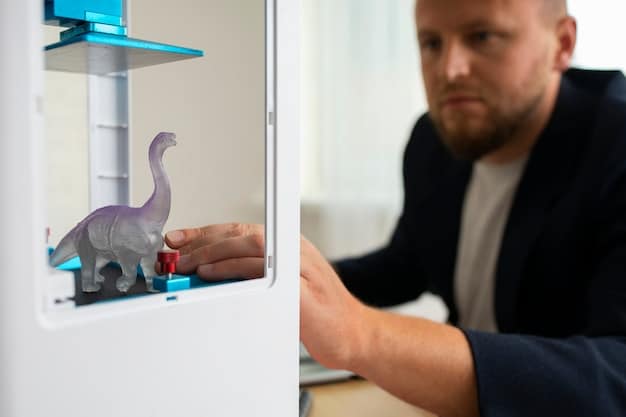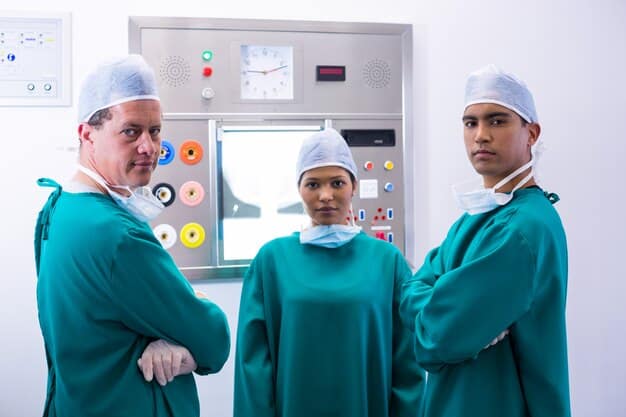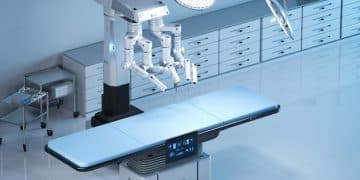3D Printing Revolutionizes US Prosthetics & Implants

3D printing technology is profoundly transforming prosthetics and implants within the US healthcare system by enabling customized, cost-effective, and rapidly produced medical solutions that significantly improve patient outcomes and accessibility to care.
The landscape of healthcare is constantly evolving, driven by technological advancements that promise better patient outcomes and more efficient treatment modalities. Among these innovations, how 3D printing is revolutionizing prosthetics and implants in the US healthcare system stands out as a particularly impactful development, offering unprecedented levels of customization, precision, and accessibility in medical devices.
the dawn of personalized medical devices
For decades, the creation of prosthetics and implants has been a painstaking process, often involving significant time, cost, and the inherent limitations of mass production. Traditional manufacturing methods struggled to account for the unique anatomical variations of each patient, leading to devices that were, at best, a compromise. This often resulted in discomfort, poor fit, and a diminished quality of life for the user.
The emergence of 3D printing, also known as additive manufacturing, has irrevocably altered this paradigm. By building objects layer by layer from a digital design file, this technology offers a level of customization previously unimaginable. It moves beyond the “one-size-fits-all” approach, ushering in an era of truly personalized medicine where devices are tailored to the individual’s exact specifications.
precision and patient-specific solutions
One of the most profound impacts of 3D printing is its capacity for extreme precision. Medical imaging techniques like MRI and CT scans can now generate highly accurate 3D models of a patient’s anatomy. These digital models are then fed directly into a 3D printer, which can create a replica of the bone, joint, or limb that needs replacement or support. This ensures a perfect fit, reducing the need for costly and time-consuming alterations post-production.
- Reduced surgical time due to better fitting implants.
- Improved comfort and functionality for patients.
- Lower risk of complications associated with ill-fitting devices.
- Enhanced aesthetic appeal for external prosthetics.
In the US, this capability translates into a healthcare system that can offer more effective and humane solutions. Patients are experiencing devices that seamlessly integrate with their bodies, improving mobility, reducing pain, and restoring a greater sense of normalcy. This level of personalization extends beyond just fit; it also encompasses the ability to incorporate specific features or functionalities that cater to a patient’s unique lifestyle or needs, from specialized athletic prosthetics to highly sensitive tactile implants.
The ability to iterate on designs quickly and affordably also means that prototypes can be developed and tested with unprecedented speed, shortening the lead time from diagnosis to device implantation. This agility is particularly crucial in cases where time is of the essence, such as in reconstructive surgery following traumatic injuries.
cost-effectiveness and accessibility
While often perceived as a cutting-edge and therefore expensive technology, 3D printing is, in many ways, driving down the costs associated with prosthetics and implants. Traditional manufacturing requires molds, tooling, and large production runs to achieve economies of scale. These high upfront costs often meant that bespoke devices were prohibitively expensive for most patients, or hospitals were forced to settle for generic options.
3D printing significantly reduces these barriers. It allows for on-demand manufacturing, meaning devices are produced only when needed, minimizing waste and storage costs. The same printer can produce a wide variety of different devices simply by changing the digital design file, eliminating the need for specialized machinery for each product type. This flexibility and efficiency contribute to a more streamlined and cost-effective production process.

reducing manufacturing overheads
The reduction in tooling and labor costs associated with 3D printing is substantial. Unlike conventional subtractive manufacturing which carves away material, additive manufacturing uses only the material necessary, leading to significantly less waste. This is particularly important with expensive biocompatible materials used in medical applications.
- Elimination of expensive tooling and molds.
- Reduced material waste during production.
- Lower inventory costs due to on-demand manufacturing.
- Potential for distributed manufacturing models, closer to hospitals and patients.
Furthermore, the localized production potential of 3D printing can enhance accessibility, especially in remote or underserved areas. Instead of relying on a centralized manufacturing facility, hospitals or even clinics could potentially house 3D printers, allowing for rapid creation and delivery of custom devices. This reduces shipping costs and logistical complexities, making life-changing prosthetics and implants more readily available across the diverse geographic landscape of the US healthcare system.
This increased accessibility is not merely about geography; it’s also about democratizing advanced medical care. As costs come down and production capabilities decentralize, more patients, regardless of their socioeconomic status or location, can benefit from personalized, high-quality medical devices. This evolution is vital for fostering a more equitable healthcare system, ensuring that innovative treatments are not just for the privileged few.
advancements in materials and biocompatibility
The effectiveness of prosthetics and implants hinges not only on their design and fit but also critically on the materials from which they are made. These materials must be biocompatible (not harmful to living tissue), durable, and often possess specific mechanical properties to withstand the stresses of the human body. 3D printing has spurred significant innovation in this area, allowing for the use of a wider range of advanced materials and even the creation of novel composite structures.
Historically, implants were often made from standard metals like titanium or stainless steel, or certain polymers. While effective, these materials sometimes lacked the ideal properties for integrating seamlessly with the body’s natural tissues. 3D printing’s ability to precisely deposit layers allows for the use of more sophisticated and challenging materials, including complex ceramics, advanced polymers, and even bioprinted living tissues.
tailoring material properties
One of the most exciting aspects of 3D printing in this context is the ability to customize material properties within a single device. For instance, an implant might require a porous structure to encourage bone ingrowth in one section, while demanding a solid, load-bearing structure in another. This level of material gradient and internal architecture is extremely difficult, if not impossible, to achieve with traditional manufacturing but is well within the capabilities of advanced 3D printers.
- Use of biocompatible titanium, PEEK, and custom polymers.
- Development of porous structures to promote bone integration.
- Bioprinting of living tissues for regenerative medicine.
- Integration of sensor technologies directly into printed devices.
Innovations include the 3D printing of medical-grade titanium, which is highly prized for its strength, lightness, and biocompatibility. Furthermore, polymer-based materials like PEEK (polyether ether ketone) are increasingly being used due to their excellent mechanical properties and radiolucency (allowing for clearer imaging post-implantation). The development of these specialized materials, coupled with the precision of 3D printing, opens up new avenues for creating devices that are not just replacements but actively promote healing and integration with the body.
The cutting edge of this field involves bioprinting, where living cells and biomaterials are used as “inks” to create functional tissues and organs. While still largely in the research phase for full organ transplantation, bioprinting is already showing promise for creating skin grafts, cartilage, and even vascular structures for more complex implants, hinting at a future where implants are not just inert foreign bodies but living, growing parts of the patient.
challenges and regulatory considerations
Despite its transformative potential, the widespread adoption of 3D printing in the creation of prosthetics and implants in the US healthcare system faces several hurdles. These include rigorous regulatory oversight, the need for specialized expertise, and the ongoing development of standardized protocols for quality control.
The U.S. Food and Drug Administration (FDA) plays a crucial role in ensuring the safety and effectiveness of medical devices. For 3D-printed devices, the FDA has been working to establish clear guidelines that address the unique aspects of additive manufacturing, such as material variability, software validation, and post-market surveillance. While the FDA has approved numerous 3D-printed medical devices, the inherent customization of these products means that each iteration or unique design might require individual scrutiny, which can slow down market entry.
navigating the regulatory landscape
The bespoke nature of 3D-printed prosthetics and implants presents a unique challenge for regulators. Unlike mass-produced items where a single approval covers millions of identical products, each custom-printed device is, in essence, a unique product. This necessitates a robust framework for ensuring quality and safety at every step of the design and manufacturing process, from raw material validation to final product sterilization.
- Rigorous FDA approval processes for custom devices.
- Need for standardized validation and quality control protocols.
- Addressing cybersecurity risks in digital design files.
- Ensuring long-term durability and biocompatibility.
Furthermore, developing the necessary expertise within the healthcare workforce is critical. Clinicians need to understand the capabilities and limitations of 3D printing, while engineers and technicians require specialized training in medical device design, materials science, and additive manufacturing processes. Bridging this skills gap is essential for maximizing the benefits of this technology.
Another significant consideration is intellectual property and data security. The digital blueprints for these custom devices contain highly sensitive patient data and proprietary design information. Safeguarding these digital assets from cyber threats and ensuring proper data governance is paramount to maintaining patient trust and industry integrity. Addressing these challenges effectively will pave the way for 3D printing to fulfill its promise as a cornerstone of modern medical device manufacturing.
case studies and success stories in the us
The theoretical benefits of 3D printing in healthcare are already being realized through numerous compelling case studies across the US. From complex surgical guides to life-changing custom prosthetics, these real-world applications demonstrate the profound impact of this technology on patient lives and medical practice.
One notable area of success is in craniomaxillofacial surgery. Surgeons are using 3D-printed models derived from patient CT scans to precisely plan complex reconstructive surgeries, simulate procedures, and even create custom implants for facial and skull reconstruction. This not only improves surgical accuracy but also significantly reduces operative time, leading to better patient outcomes and faster recovery.
transforming surgical planning and patient care
Hospitals like Mayo Clinic and Walter Reed National Military Medical Center have been at the forefront of integrating 3D printing into their clinical workflows. These institutions are using additive manufacturing to create patient-specific anatomical models for pre-surgical planning, allowing medical teams to visualize complex pathological anatomy and practice challenging procedures before entering the operating room. This reduces surprises during surgery and enhances precision.
- Custom cranial and facial implants for reconstructive surgery.
- Patient-specific cutting guides for orthopedic procedures.
- Personalized hearing aids and dental aligners.
- Aesthetic and functional prosthetic limbs for amputees.

Beyond implants, 3D printing is revolutionizing external prosthetics. Companies and research centers are developing extremely lightweight, comfortable, and functional prosthetic limbs that are perfectly tailored to the user’s residual limb. These custom-fit prosthetics can dramatically improve comfort, reduce pain from friction, and enhance the user’s ability to perform daily activities. Many veterans, for instance, have greatly benefited from custom 3D-printed prosthetics developed by specialized programs aimed at optimizing their rehabilitation and reintegration into civilian life.
Similarly, the dental industry has widely adopted 3D printing for creating custom dental aligners, crowns, and bridges. This has streamlined processes, reduced the need for multiple patient visits, and provided more precise and aesthetically pleasing results. These myriad success stories underscore that 3D printing is not just a futuristic concept but a vital tool actively reshaping and significantly improving the delivery of healthcare in the United States today.
the future outlook and predictive trends
The journey of 3D printing in healthcare is far from complete; it’s an evolving field with significant potential for future growth and innovation. Predictive trends suggest that we will see increasingly sophisticated materials, more integrated digital workflows, and a broader array of 3D-printed devices moving through clinical trials and into mainstream adoption in the US healthcare system.
One major trend is the ongoing development of “smart” implants that incorporate sensors to monitor patient health, device performance, or even deliver medication. Imagine an orthopedic implant that can detect early signs of infection or a prosthetic limb that provides haptic feedback to the user. 3D printing’s ability to create complex internal geometries makes such integration feasible, paving the way for truly intelligent medical devices.
integration of artificial intelligence and machine learning
The future of 3D printing in medicine will also be heavily influenced by the integration of artificial intelligence (AI) and machine learning (ML). AI can analyze vast amounts of patient data to optimize implant design, predict material performance, and even automate aspects of the design and printing process. ML algorithms can learn from previous successes and failures, continuously improving the efficiency and effectiveness of 3D printing workflows, leading to more robust and reliable medical devices.
- Development of “smart” implants with embedded sensors.
- Expansion of bioprinting for complex tissue and organ regeneration.
- Increased automation and AI-driven design optimization.
- Greater integration of 3D printing at point-of-care facilities.
Furthermore, expect to see an expansion of bioprinting beyond simple tissues to more complex organ structures, gradually nearing the goal of printing fully functional organs for transplantation. While still a long-term vision, advancements in cell manipulation, biomaterials, and printer resolution are steadily bringing this closer to reality. The FDA is actively engaging with researchers and industry to prepare for the regulatory challenges and ethical considerations that such breakthroughs will present, ensuring that new technologies are introduced safely and responsibly.
Ultimately, the continuous refinement of 3D printing technology, coupled with decreasing costs and growing acceptance, suggests that it will become an indispensable tool in the US healthcare arsenal. It promises a future where medical devices are not just standard solutions but highly personalized, intelligent, and regenerative components that seamlessly integrate with the human body, profoundly improving health and quality of life for millions.
economic impact and the healthcare market
The revolutionary advancements brought by 3D printing in prosthetics and implants are not isolated to clinical outcomes alone; they are also generating a significant economic ripple effect within the US healthcare market. This technology is creating new industries, stimulating innovation, and potentially reshaping how medical device companies operate and compete.
Estimates suggest a substantial growth in the additive manufacturing medical device market. This growth is driven by increasing demand for personalized medicine, the aging population, and the continuous innovation in materials and printing techniques. This translates into new job opportunities, from specialized engineers and material scientists to clinical staff trained in using and managing 3D-printed solutions.
market disruption and investment opportunities
Traditional medical device manufacturers are recognizing the transformative power of 3D printing and are either investing heavily in their own additive manufacturing capabilities or acquiring smaller, specialized 3D printing firms. This shift is redefining supply chains, moving towards more localized and agile production models. It represents a significant disruption to conventional manufacturing processes, forcing established players to adapt or risk being outpaced by more innovative companies.
- Growth of the personalized medical device market.
- New job creation in specialized engineering and manufacturing.
- Increased investment in R&D for medical 3D printing.
- Potential for smaller companies to enter the medical device market.
Moreover, the ability to rapidly prototype and iterate designs with 3D printing significantly shortens the product development lifecycle. This reduction in time-to-market can lead to faster return on investment for companies, encouraging further research and development in the field. This agility is particularly advantageous in a competitive and rapidly evolving industry where being first to market with innovative solutions can provide a significant competitive edge.
The economic impact also extends to healthcare providers. As 3D printing becomes more integrated into hospitals and clinics, there’s potential for enhanced efficiency and cost savings, particularly in complex surgeries or for patients requiring highly customized care. By reducing the need for costly external manufacturing and potentially lowering revision surgeries due to better fit, 3D printing offers a compelling economic argument alongside its clinical benefits, driving its continued adoption across the United States healthcare system.
| Key Aspect | Brief Description |
|---|---|
| 📏 Precision & Customization | Enables patient-specific prosthetics and implants with exact anatomical fit, enhancing comfort and function. |
| 💲 Cost-Efficiency | Reduces manufacturing waste, tooling costs, and allows on-demand production, making advanced care more accessible. |
| 🧪 Material Innovation | Allows for novel biocompatible materials and complex internal structures, including potential for bioprinting living tissues. |
| 📈 Future Growth | Anticipated integration with AI, smart sensors, and expanded bioprinting applications, driving significant market expansion. |
frequently asked questions about 3d printing in healthcare
▼
Currently, a wide range of devices are 3D printed, including custom cranial implants, joint replacements (hips, knees), spinal cages, dental prosthetics (crowns, bridges, aligners), surgical guides, and external prosthetic limbs. This technology enables patient-specific designs, vastly improving fit and functionality.
▼
3D printing reduces costs by minimizing material waste; eliminating the need for expensive molds and tooling; allowing for on-demand, localized production; and streamlining the iterative design process. This efficiency makes customized devices more affordable and accessible to a broader patient population.
▼
Yes, the FDA actively regulates 3D-printed medical devices in the US. They have established specific guidelines and approval pathways to ensure the safety, effectiveness, and quality control of these devices, acknowledging the unique challenges posed by their customized nature and diverse materials.
▼
The primary advantages include unparalleled customization for a perfect patient-specific fit, leading to better comfort and reduced complications. They also offer the ability to incorporate complex internal structures to promote bone ingrowth, and faster production times, improving overall patient outcomes.
▼
The future potential is immense, particularly in bioprinting. Researchers are working towards printing complex tissues and even organs using living cells, which could revolutionize transplantation, drug testing, and disease modeling by creating functional, patient-specific biological structures for regenerative therapies.
conclusion
The transformative power of 3D printing on prosthetics and implants within the US healthcare system is undeniable. What began as a niche manufacturing technique has rapidly evolved into a cornerstone of personalized medicine, offering unparalleled precision, cost-efficiency, and innovation in materials. As regulatory frameworks adapt and technological capabilities expand, the integration of 3D printing promises a future where medical devices are not merely functional replacements but truly custom-engineered solutions that enhance lives, accelerate recovery, and democratize access to advanced healthcare. The journey is ongoing, but its impact is already profoundly reshaping how we approach patient care and medical device innovation.





